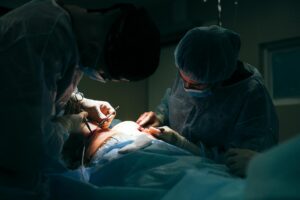
When you are ready to embark on the parenting journey, your breast implants might be a concern you weren’t expecting. Whether you have been happy with your implants since you got them or had second doubts about your choice occasionally, the idea of going through pregnancy and breastfeeding with implants might seem like a daunting challenge.
Is Breast Implant Removal Really a Thing?
It may surprise you to learn that many women who have invested in breast implants are now keen to return to their plastic surgeons to have them removed. The proof is evident in recent numbers. Last year, the Surgical Times reported a 47% increase in implant removal procedures (also known as explantation) in 2021. Women opting for alternative breast enhancement methods, such as fat grafting, also increased.
Fewer women are choosing to undergo breast implant surgery. The Aesthetic Society released data in 2020 showing breast implant procedures were declining – a trend that continues. Why the change of heart?
Reasons Behind the Implant Removal Decision
Whether the trend began with an uptick in celebrities removing their implants or simply jumping on the bandwagon, the public confessions of breast implant removals by notable stars have likely fueled the implant removal movement. Women like Danica Patrick, Rhylee Gerber, and Chrissy Teigen have been candid about their decision to get implants – and to have them removed.
A common reason behind the removal decision among celebrities is concerns that the implants are affecting their health. A slew of vague symptoms, from memory loss to joint pain, have been reported, and many women who experienced symptoms said they felt better immediately after having the implants removed.
Other common reasons women choose implant removal include:
- Difficulties sleeping with the additional breast size
- Worries over the accuracy of mammogram results
Implant-related complications like capsular contracture or rupture - Dissatisfaction with the appearance of the implants
- Back or shoulder pain due to large implants
- Concerns about symptoms of breast implant illness (BII)
- Risks associated with a rare form of lymphoma known as BIA-ALCLIn
- Interference with some activities
- Difficulty finding clothing that fits properly
- Uncertainty regarding how implants might affect pregnancy and breastfeeding
Benefits of Breast Implant Removal
The benefits of breast implant removal may vary based on the reasons behind having them removed in the first place. First and foremost, women often experience a boost in self-confidence after losing the implants, as they discover the natural look can be more attractive than expected. Other benefits of implant removal include:
● Improvement in symptoms related to BII
● Peace of mind over BIA-ALCL risk
● Elimination of MRIs to detect ruptures
● Greater physical comfort
● Better nights of sleep
● Long-lasting results
Implant Removal Surgery and Pregnancy: What You Need to Know

You are not alone if you are concerned about how implant removal surgery might affect future pregnancies. This is a common concern for many women, but fortunately, it is mostly unfounded. Implant removal is a safe procedure when performed by an experienced, board-certified plastic surgeon.
Most surgeons recommend waiting between implant removal and pregnancy to give the body ample time to heal from surgery before beginning the rigors of the pregnancy journey. Six months to one year is a good general guideline to follow. However, if you get pregnant earlier than this timeframe, there is no reason to believe the previous surgery will affect your growing
baby.
A greater concern is how implants might affect the natural breast changes during pregnancy. As the body prepares to feed the newborn, the breasts increase in size to prepare themselves for milk production. The difference in size strains on the surrounding skin, which can lead to stretch marks and drooping breasts after the baby is born. Implants in the breasts can exacerbate these
changes due to their weight and size.
Implants might also impact your ability to sleep soundly, particularly as your growing stomach poses an additional challenge. Sleep is critical for both you and your growing baby for those nine important months, so any steps you can take to make yourself more comfortable at night
will likely be welcome.
Implant Removal Surgery and Breastfeeding: What You Need to Know
While many women who have implants – or have them removed – can successfully breastfeed, there are some factors to consider. First is the placement of the incision. Some surgeons will use an incision around the areola and nipple to place an implant in the breast tissue. This location can also be used to remove implants.
Insicions, can in some cases affect milk supply and a woman’s ability to breastfeed. When the incisions are done properly and with a higher level of expertise, the incisions will not be an important factor.
Volume of the implant is another consideration. The placement of an implant, whether it is underneath the chest muscle (submuscular placement), under the fascia (subfascial placement), or on top of the muscle (subglandular placement), can sometimes cause pressure on the ducts, impairing milk flow.
Whether you are getting implants or having them removed, discussing your future family plans with your surgeon is essential to preserve your ability to breastfeed.
Your Choice of Plastic Surgeon Matters

When it comes to breast implant removal, not all plastic surgeons offer the same results. Women who fear drooping or deflated breasts after implant removal surgery should search for a surgeon with expertise in rebuilding the breast mound during the explantation process to ensure
the best possible aesthetic outcome.
In my practice, we use a proprietary technique for implant removal known as the BRALAN procedure or breast reconstruction anatomical lift augmentation. I create an L-shaped scar in the lower portion of the breast that minimizes visible scarring after surgery and leaves the natural cleavage line untouched. I remove both the implant and the capsule surrounding it through the incision, leaving only healthy breast tissue behind. I then reposition the remaining breast tissue to produce a beautiful, natural breast mound.
If necessary, I can also lift the breast to address drooping and enhance the projection and position of the breasts. This approach ensures my patients wake from surgery without implants but with an aesthetically pleasing breast contour.
Other Techniques
In addition to BRALAN, I offer proprietary techniques in breast enhancement for women who would like to restore their pre-pregnancy shape once their family is completed. BRA LIFT (breast reconstruction anatomical lift) focuses on reversing the effects of gravity on the breasts, lifting them to a more youthful position on the chest. If necessary, I can also remodel the nipple and areola to produce a natural and proportionate appearance.
Women left with heavy, pendulous breasts after the pregnancy and breastfeeding experience may benefit from my BRAR (breast reconstruction anatomical reduction) technique. This procedure removes excess breast tissue weighing down the breasts and putting pressure on the neck, shoulders, and back. At the same time, I reshape the remaining breast tissue and raise the position of the breasts if necessary to produce an optimal outcome.
If pregnancy is on your horizon, now may be the right time to decide whether you want to keep your implants in your new mommy role or remove them before the journey begins. The choice is highly personal and needs to be made between you and your surgeon. The right decision is the one you are most comfortable making for yourself and your future babies.